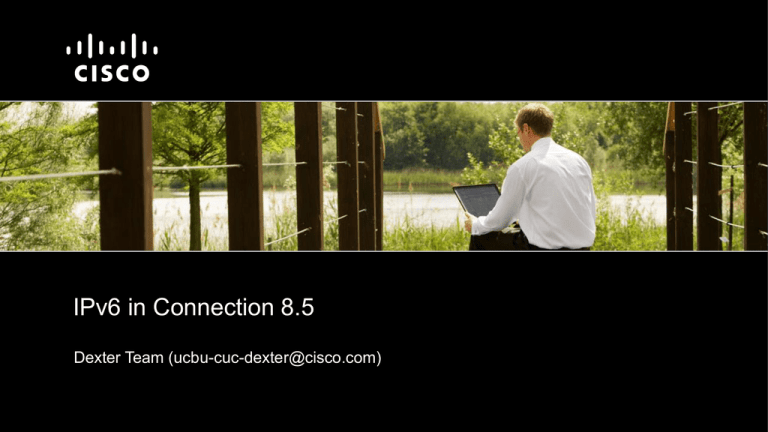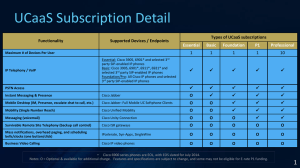
IPv6 in Connection 8.5
Dexter Team (ucbu-cuc-dexter@cisco.com)
IPv6 Support in Connection 8.5
IPv6 is supported with the following connections in CUC 8.5:
SCCP phone system integrations with CUCM 7.1(2) and later
SIP phone system integrations with CUCM 8.5 and later (ANAT must be enabled)
Disabled by default.
IPv6 is NOT supported in Cisco Unified Communications Manager
Business Edition (CUCMBE).
Presentation_ID
© 2009 Cisco Systems, Inc. All rights reserved.
Cisco Confidential
2
Configuration: Enable IPv6 and Configure Address
Cisco Unified OS Administration: Settings > IP > Ethernet IPv6 Configuration
We recommend using a static
non-link-local IPv6 address.
Reboot required for changes to
take effect.
Presentation_ID
© 2009 Cisco Systems, Inc. All rights reserved.
Cisco Confidential
3
Alternate Configuration: Enable IPv6 and Configure Address
As an alternative to using Cisco Unified OS Administration, you can use CLI
commands to enable IPv6 and configure the IPv6 address:
Enable IPv6 by using the set network ipv6 service enable command.
Set a static IPv6 address for your server by using the set network ipv6 static_address
<addr> <mask> command. The DHCPv6 client is also supported, but its use is not
recommended.
To view the platform's IPv6 address settings, use the show network ipv6 settings
command.
Presentation_ID
© 2009 Cisco Systems, Inc. All rights reserved.
Cisco Confidential
4
Configuration (Continued): Configure CUCM
Creating an integration:
CUCM SCCP Integration Guide for CUC Release 8.x
CUCM SIP Trunk Integration Guide for CUC Release 8.x
Adding IPv6 to an existing integration:
Follow the steps in the “Configuration Checklist for IPv6” section in the “Internet
Protocol Version 6” chapter of the CUCM Features and Services Guide for your
release of CUCM.
For SIP integrations, don’t forget to configure the SIP trunk with the
CUC IPv6 destination address and reset the trunk.
(In Cisco Unified CM Administration, on the Device menu, select Trunk. Find the
trunk corresponding to the CUC server. On the Trunk Configuration page,
change the value of the Destination Address IPv6 field, save the change, and
reset the trunk.)
Presentation_ID
© 2009 Cisco Systems, Inc. All rights reserved.
Cisco Confidential
5
Configuration (Continued): IP Addressing Mode
CUC Administration: System Settings > General Configuration
See speaker
notes for field
definitions
Presentation_ID
© 2009 Cisco Systems, Inc. All rights reserved.
Cisco Confidential
6
Configuration (Continued): Configuring CUCM IPv6
Addresses in Connection 8.5 (SCCP or SIP)
CUC Administration: Telephony Integrations > Port Group > Edit > Servers
See speaker
notes for field
definitions
Presentation_ID
© 2009 Cisco Systems, Inc. All rights reserved.
Cisco Confidential
7
Configuration (Continued): Configuring IP
Addressing Mode Preference for SCCP Integrations
CUC Administration: Telephony Integrations > Port Group > Edit > Servers
See speaker
notes for field
definitions
Presentation_ID
© 2009 Cisco Systems, Inc. All rights reserved.
Cisco Confidential
8
Configuration (Continued): Configuring IP
Addressing Mode Preference for SIP Integrations
CUC Administration: Telephony Integrations > Port Group > Edit > Servers
See speaker
notes for field
definitions
Presentation_ID
© 2009 Cisco Systems, Inc. All rights reserved.
Cisco Confidential
9
Additional Considerations
The CTL file required for security features (authentication and
encryption) for SCCP integrations uses IPv4 addressing. Therefore, in
order to use authentication and encryption with SCCP secure ports,
you must retain the IPv4 address or host name for the Cisco
Unified CM server(s) on the port group in Connection.
For information on setting up SCCP secure ports, see the CUCM SCCP Integration
Guide for CUC Release 8.x. (Appendix: Cisco Unified Communications Manager
Authentication and Encryption of Cisco Unity Connection Voice Messaging Ports)
Presentation_ID
© 2009 Cisco Systems, Inc. All rights reserved.
Cisco Confidential
10
Additional Considerations (Continued)
Some versions of Cisco Adaptive Security Appliance (ASA) do not
support application inspection for IPv6 traffic for Unified
Communications application servers and endpoints. Cisco
recommends not using IPv6 for Unified Communications if you are
using a Cisco ASA version that does not provide this support. See the
documentation for your version of Cisco ASA to determine whether
application inspection is supported in your deployment.
Presentation_ID
© 2009 Cisco Systems, Inc. All rights reserved.
Cisco Confidential
11
Additional Considerations (Continued)
The Port Test and Port Group Test utilities (in the Related Links box
on SCCP integration port and port group pages in Cisco Unity
Connection Administration) do not test IPv6 connectivity. Even when
Connection is configured to use IPv6 for a SCCP integration, the
utilities confirm that Connection can communicate with the phone
system by using IPv4 addressing.
Presentation_ID
© 2009 Cisco Systems, Inc. All rights reserved.
Cisco Confidential
12
Troubleshooting IPv6
To show port registration details, you can turn on the MiuIO level 12 micro trace,
and/or the Call Control (Miu) Traces macro trace (for SIP or SCCP as applicable).
The traces can be collected in the diag_CuCsMgr_<NNNNNNNN>.uc log files.
Presentation_ID
© 2009 Cisco Systems, Inc. All rights reserved.
Cisco Confidential
13








